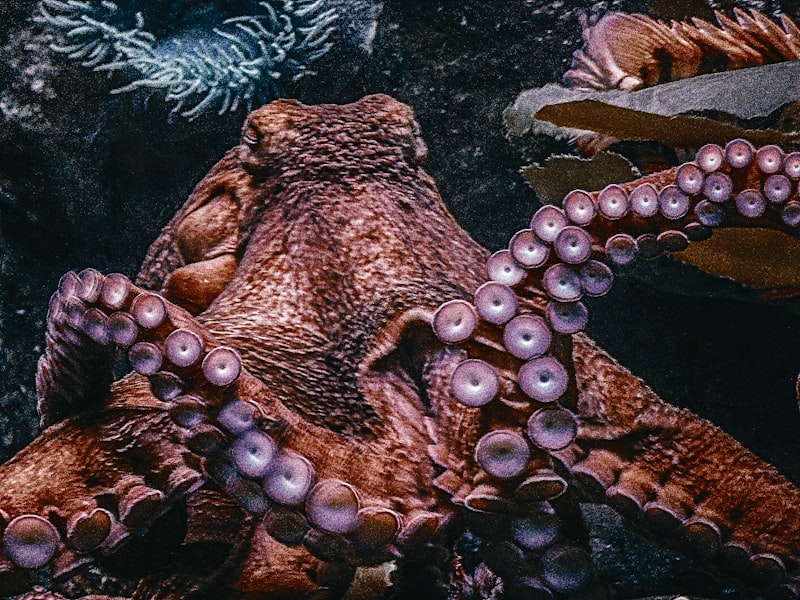Octopuses are known for their incredible adaptability and cunning. With their soft bodies and lack of bones, they can squeeze through unbelievably small openings, making them the ultimate escape artists. Imagine fitting through a hole the size of a coin—that’s just another day for these flexible beings!
One of the most fascinating aspects of octopuses is their unparalleled skill in camouflage. They can change both the color and texture of their skin to blend seamlessly with their surroundings, whether it’s a coral reef, a rocky seabed, or even sandy plains. This ability isn’t just for show; it’s a critical survival tactic used to evade predators and sneak up on prey.

But their intelligence goes beyond mere camouflage. Octopuses are curious creatures with problem-solving abilities that rival some mammals. They’ve been observed using tools, such as rocks and shells, to build protective fortresses around their dens. This level of cognitive ability hints at a complex inner world beneath their watery exterior.
Another intriguing behavior of octopuses is their distinct personalities. Each individual seems to exhibit its own quirks and preferences, from shy and timid to bold and adventurous. Some scientists even suggest they can learn and remember specific tasks—a trait previously thought to be exclusive to vertebrates.
Octopuses also have a surprising social side. While they are typically solitary creatures, they occasionally interact with one another, often during mating season. They use a variety of signals, including color changes and posturing, to communicate their intentions and avoid conflict.
Octopuses are truly fascinating creatures of the deep, blending intelligence, adaptability, and a hint of mystery into their everyday lives. Whether you’re captivated by their shape-shifting abilities or their complex social behaviors, there’s no denying the allure of these underwater marvels.
Masters of Disguise: How Octopuses Use Camouflage to Evade Predators

Ever wondered how octopuses manage to disappear right before your eyes? These incredible sea creatures are true masters of disguise, using camouflage techniques that put even the most advanced military gear to shame.
Octopuses have specialized skin cells called chromatophores, which contain pigment that can change color instantly. This ability allows them to blend seamlessly with their surroundings, whether it’s a rocky seabed or a coral reef bustling with life. But it doesn’t stop there—octopuses can also alter the texture of their skin to mimic the shape and appearance of nearby objects like rocks, plants, or even other animals.
Imagine a hungry predator swimming by—a lurking shark or a curious seal. In an instant, the octopus transforms, adopting the colors and patterns of the ocean floor or the swaying algae. It’s a survival strategy honed over millions of years of evolution, where the slightest twitch of a muscle can mean the difference between becoming a meal or slipping away unnoticed.
What’s truly astonishing is the octopus’s ability to not only change its appearance but also to anticipate and react to threats in real-time. This dynamic camouflage isn’t just about blending in; it’s about actively avoiding danger. Scientists marvel at how these creatures seem to possess an innate understanding of their environment, using their camouflage not just as a defense mechanism, but as a tool for hunting and navigating their underwater world.
Next time you catch a glimpse of an octopus in its natural habitat, take a moment to appreciate the mastery behind its disappearing act. It’s a reminder of nature’s endless ingenuity and the remarkable ways in which evolution has equipped even the most seemingly vulnerable creatures with extraordinary defenses.
The Brainy Eight-Armed Wonders: Unraveling the Intelligence of Octopuses
Have you ever wondered about the incredible intelligence lurking beneath the waves? Enter the mysterious world of octopuses, where eight arms hold more than meets the eye. These fascinating creatures, with their unique abilities and complex behaviors, continue to intrigue scientists and ocean enthusiasts alike.
Octopuses are renowned for their problem-solving skills and adaptability. With a decentralized nervous system, they exhibit a level of intelligence that rivals some vertebrates. Imagine navigating the ocean depths with a brain that extends into each of their arms, allowing them to perform tasks independently, almost as if each arm has a mind of its own.
One of the most remarkable aspects of octopus intelligence is their ability to learn and remember. They can solve puzzles, open jars to retrieve food, and even mimic other species for camouflage. This cognitive flexibility suggests a sophisticated level of learning that extends beyond mere instinct.
In the realm of survival tactics, octopuses are masters of disguise. Using specialized skin cells called chromatophores, they change color and texture in milliseconds, blending seamlessly with their surroundings. This camouflage isn’t just for show; it’s a strategic advantage that helps them evade predators and sneak up on prey.
Furthermore, octopuses exhibit curiosity, a trait typically associated with higher intelligence. They explore their environment, manipulate objects, and interact with their surroundings in ways that hint at a deeper understanding of their world.
Scientists continue to uncover new insights into octopus intelligence, challenging our understanding of cognition and consciousness in non-human animals. Each discovery opens a window into the evolution of intelligence on Earth, showing that intelligence comes in many forms, not just those with a backbone.
Next time you marvel at the wonders of the ocean, spare a thought for the octopus—an eight-armed enigma that defies expectations and expands our understanding of intelligence in the animal kingdom.
This article celebrates the marvels of octopus intelligence while maintaining a conversational tone and engaging the reader with fascinating facts and analogies.
From Solitary Hunters to Social Strategists: Understanding Octopus Behavior
Octopuses are primarily solitary hunters, prowling the ocean depths in search of prey. Their keen eyesight and superb camouflage abilities make them expert ambush predators. They patiently wait for the perfect moment to strike, using their tentacles to capture unsuspecting crustaceans and fish. This solitary hunting behavior not only showcases their hunting prowess but also underscores their role as efficient marine predators.
Despite their solitary nature during hunting, octopuses are surprisingly social creatures in certain contexts. They exhibit complex behaviors when interacting with conspecifics, especially during mating or territorial disputes. These interactions often involve intricate displays of color-changing and posturing, which serve as communication signals among individuals. Such social behaviors demonstrate that octopuses possess a sophisticated level of social intelligence, challenging the notion that they are purely solitary animals.
One of the most remarkable aspects of octopus behavior is their problem-solving ability. In controlled experiments, octopuses have been observed using tools, solving puzzles, and even escaping from enclosed spaces—a testament to their cognitive flexibility and ingenuity. These behaviors highlight their capacity for learning and adaptation, traits that are crucial for survival in their dynamic marine environments.
Octopuses exhibit a spectrum of behaviors ranging from solitary hunting to complex social interactions and cognitive feats. Their ability to adapt to various ecological niches and challenges underscores their evolutionary success as marine predators. By delving deeper into the study of octopus behavior, scientists continue to uncover new insights into the intelligence and adaptability of these enigmatic creatures.
Ingenious Escapists: The Art of Houdini-like Moves in Octopus Predation
Imagine a predator lurking in the shadows, its eyes fixed on its prey—a clever octopus. In a split second, the octopus transforms, blending seamlessly into its surroundings like a master of disguise. Its skin changes color and texture, camouflaging perfectly against rocks or coral. This ability not only helps it evade predators but also allows it to launch surprise attacks on unsuspecting prey.
But the octopus’s repertoire of Houdini-like maneuvers doesn’t end there. When confronted directly, these cephalopods unleash an impressive array of escape tactics. They are masters of contortion, squeezing through impossibly tight spaces to slip away from danger. Their soft bodies, lacking any rigid structure, allow them to fit through openings that seem too small to be possible—an evolutionary marvel that has puzzled scientists for decades.
Moreover, the octopus is equipped with another extraordinary trick up its sleeve—literally. Each arm is lined with hundreds of suckers, equipped with an incredible sense of touch. These suckers not only help the octopus manipulate objects with precision but also provide a firm grip on slippery surfaces. In the face of danger, they can cling onto rocks or pry open shells to access hidden prey, all while executing evasive maneuvers with the grace of a seasoned escape artist.
In essence, the art of Houdini-like moves in octopus predation showcases nature’s brilliance at its finest. These creatures have honed their skills over millions of years, adapting and evolving to become the ultimate escapists of the deep. Their ability to blend, contort, and outmaneuver predators is a testament to the power of evolution and the ingenuity of life under the sea.
Eerie Intelligence: How Octopuses Solve Complex Problems in the Wild
Imagine the depths of the ocean where a creature with eerie intelligence roams freely— the octopus. These remarkable beings possess a level of problem-solving skills that astonish scientists and enthusiasts alike. In the wild, octopuses face a myriad of challenges from hunting prey to avoiding predators, and they tackle these with a finesse that seems almost supernatural.
One of the most intriguing aspects of octopus intelligence is their ability to adapt and learn quickly. Unlike many other creatures, they don’t rely solely on instinct but actively engage their environment with curiosity and cunning. For instance, researchers have observed octopuses using tools, such as carrying coconut shells for protection or camouflaging themselves with surrounding objects to evade detection.
Their problem-solving capabilities extend beyond mere survival tactics. Octopuses have been known to demonstrate complex behaviors like opening jars to access food or navigating through mazes to reach a reward. These actions showcase not only their intelligence but also their capacity for learning and memory retention.
Moreover, octopuses exhibit a level of creativity in problem-solving that’s both fascinating and perplexing. They can devise novel solutions to challenges they encounter, employing strategies that often surprise researchers. This ability hints at a sophisticated cognitive toolkit that allows them to adapt swiftly to changing circumstances in their aquatic habitat.
Octopuses stand out in the animal kingdom for their eerie intelligence and remarkable problem-solving skills. Their ability to navigate complex situations with creativity and adaptability underscores their status as some of nature’s most intriguing creatures. Studying these enigmatic beings continues to unveil new insights into the depths of animal cognition and what it means to be truly intelligent in the wild.
Frequently Asked Questions
What are some fascinating behaviors of octopuses?
Discover the intriguing behaviors of octopuses, such as their remarkable camouflage abilities, problem-solving skills, and complex social interactions. Explore how these creatures use their intelligence to adapt to various environments and interact with their surroundings in unique ways.
How do octopuses defend themselves from predators?
Discover how octopuses defend themselves from predators through camouflage, ink expulsion, and jet propulsion. Their ability to change color and texture helps them blend into surroundings, while releasing ink confuses attackers. Additionally, they can swiftly escape using water jet propulsion, aiding in evasion.
How do octopuses reproduce and care for their young?
Learn about octopus reproduction and parental care. Discover how octopuses reproduce through mating, with the male transferring sperm packets to the female. Understand how females then lay eggs and protect them until they hatch, ensuring survival through careful guarding and cleaning. Explore the unique behaviors of octopuses in nurturing their young.
Where do octopuses live and what are their habitats like?
Discover where octopuses live and explore their diverse habitats. Learn about the unique environments they inhabit, from coral reefs to deep-sea trenches.
What is unique about the intelligence of octopuses?
Discover what sets octopuses apart in the realm of intelligence. Explore their exceptional problem-solving skills, remarkable memory capabilities, and unparalleled ability to camouflage. Learn why octopuses are considered some of the most intelligent creatures in the ocean.


